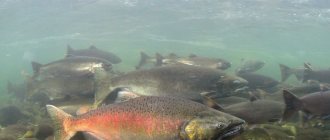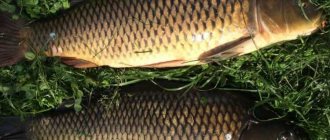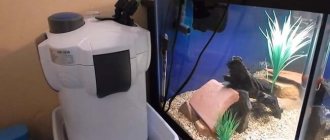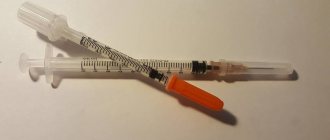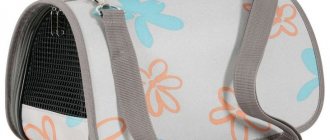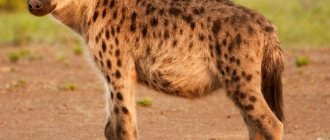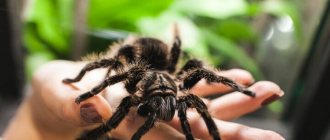Ide, like asp, belongs to the carp family, representing one of the most interesting species of the ray-finned family. This representative of cyprinids is a freshwater species, but can also tolerate slightly salty water of sea bays. The main places where this fish lives are rivers, river ponds and flowing lakes. But you won’t find it in mountain rivers with fast and powerful currents or in cold reservoirs.
The ide fish is one of the hardiest river inhabitants and can easily tolerate temperature changes, including sudden ones. At the same time, the most comfortable body of water for it is a clean, deep river with a moderate current and a silted clay bottom. It can also live in reservoirs, preferring deep places, avoiding rocky and sandy areas.
The lifespan in natural conditions ranges from 15 to 20 years. But as a rule, an ide rarely manages to live to see its 10th birthday.
Appearance
Let's figure out what ide looks like? The length of the thick body of an adult fish varies from 35 to 50 cm, and especially large individuals can reach a length of 90 cm. At the same time, the average weight is up to 3 kg , but there are also record holders, ides up to 8 kg! Moreover, representatives of the species in central Russia weigh about 1.5-2 kg. But in clean and oxygen-rich artificial reservoirs, the fish reaches very impressive sizes.
You can recognize a fish by the following signs:
- Thick body.
- Shortened head.
- Small slanted mouth.
- Large eyes.
- Usually gray in color
The body color of the ide may vary depending on the time of year or the age of the individual.
We also recommend reading:
Catching ide in the summer with a half-bottom Features of catching ide in the spring Catching burbot in December 2022 Making technoplankton with your own hands
Adult individuals have a gray, metallic body color with golden “cheeks” and head. At the same time, in the sun, the color can change , becoming either completely dark or silvery-golden. The sides are close in color to white, creamy yellow, the back is black with a blue tint. The reddish-crimson color is characteristic of the lower fin, less often – the caudal and upper fin. Some fish have a much darker dorsal and caudal fin - silver-gray with a purple tint. The scales are medium in size.
Lures for ide
The mouth of the ide is small, so it is best to use small spinners, oscillating spoons or wobblers up to four centimeters long as bait.
For float gear, you can use bait of plant origin. It is best to take canned peas, slightly air-dried, boiled corn, bread crumb, dough and others. Vanilla or sunflower oil is added to the bait.
Filamentous algae are also used as bait. From the end of spring, you can catch not only ide, but also other types of fish using mulberry. This bait is especially relevant on hot days. Young parts of the plant, up to 10 cm long, are suitable for this purpose. The shoot is tied to the shank of the hook and braided around it. Only a small tip of the shoot is left free. Such algae grow on rocky surfaces, driftwood, piles or concrete surfaces.
Also used as bait for ide are grasshoppers, caddis flies, larvae or adults of May beetles, bark beetles, and mole crickets. In winter, fish can be caught using bloodworms or worms.
Small tadpoles or frogs and small tenacious fish are used as bottom equipment.
The ide is very capricious and often neglects bait. The only thing he cannot refuse are bark beetle larvae and dragonfly nymphs.
Gallery: ide fish (25 photos)
Tackle and methods of catching ide.
Ide is of great interest for amateur and sport fishing as a large, valuable fish, which can be fished almost all year round. Its meat has high gastronomic qualities and is a source of easily digestible protein, vitamins and elements necessary for the human body, for which it is valued by nutritionists. The methods of fishing for ide are practically no different from the methods of catching chub, as is the equipment for it.
They catch ide with a float, fly fishing, spinning and bottom gear. Fishing methods and the type of gear depend on the personal preferences of the fisherman, and in some cases, on the fishing season.
For example, on winter ice, the omnivorous silvery beauty is caught with special gear: a nodding or float rod with a special winter float, which must always be immersed in the water so as not to freeze to the surface of the water.
It is impossible to say when the fishing season for this fish begins for the reason that it does not end, continuing all year round. Only during severe frosts does the ide stop pecking, but as soon as the sun warms up a little, it’s right there.
The highest feeding activity of ide is observed 5-6 days after its spawning, as well as with the onset of autumn cold spells, marked by the first signs of leaf fall. The intensity of the autumn zhora is slightly weaker than after spawning, but it occurs much longer, taking almost three weeks.
Habitat area
It has a wide distribution area:
- Most countries in Europe (except the south and southeast).
- The Arctic Ocean basin (from the White Sea rivers to the Lena).
- Bays of the Baltic Sea.
- Basin of the Aral Sea.
- The main territory of Siberia.
- Black Sea basin.
- Northern section of the Caspian basin (Volga and Ural rivers).
- North America (Connecticut in the USA).
Ide is very widespread in Ukrainian reservoirs , where it is found in almost all lakes, reservoirs and rivers.
Fishing places
As already noted, this type of fish is found in rivers and ponds. Fishing in rivers is usually easier than in ponds.
- In early spring, dams flow from major rivers to their tributaries, so they are worth looking for in some parts of the estuary.
- When fishing, it is advisable to focus on the natural habitats of the fish.
- This applies to the deepest places in the river bed, where the flow will be slower.
- Fishing in the area of spits (connecting current and calm water) or in the lower reaches of rivers can be a good idea.
In this case, it is desirable that the bottom is not silted. Also, you cannot try your hand at large rivers with a flat bottom, where this species is found in slightly smaller quantities.
Habits
The fish is a cautious fish, preferring to live in schools, often large ones. But large individuals prefer to live alone. Young roaches choose coastal zones to live , while adults prefer to live in the depths. The ide fish spends the winter at depth, hibernating together with the perch. Under the ice in spring, fish gather in schools and begin to approach the shores. When the river opens up, the flocks rise upstream, staying near the banks, without leaving the riverbed into the floodplain, except in floodplain lakes connected by channels with the river.
Spawning of ide
Sexual maturity of this species occurs at two or three years. The individual should have a weight of 250-300 g and a length of 20-25 cm. In the northern regions, sexual maturity occurs a year or two later.
Spawning of ide begins at the end of March and ends in May and depends on the weather conditions of the region. Readiness for spawning occurs when buds begin to develop on the birch tree.
Representatives of the species unite in flocks of individuals of the same age and go up the river in order to find places convenient for breeding. Most often they choose rocky rifts with a depth of 0.3 to 0.7 m. Spawning occurs in the early morning or late evening. Males swim near the surface or jump out of the water.
Spawning of ide lasts a very short period of time, usually no longer than two or three days. Ide spawns once. The spawning period may be somewhat delayed if the water has not reached the required temperature. The oldest individuals spawn first, and then the younger ones spawn. The ides leave their spawning grounds one at a time.
One female can lay from 40 to 150 thousand eggs. On average, a female weighing one and a half kilograms lays 70,000 eggs. The fish attaches its eggs to the surface of underwater vegetation or rocks. It has a light yellow color, and is practically no different from the caviar of other freshwater fish.
The larvae appear in a week and a half. Small individuals hang in the water, sticking to the surface of stones or plants for three to four days. During this time, the larvae feed on reserves from the yolk sac.
The fry stay at the spawning site for about five days, and then swim to safer places.
Yazi, which live in lakes, prefer to spawn in river mouths or in shallow water near the shore where there is dense vegetation.
After spawning, the ide goes deeper and begins to look for food at an accelerated pace. This period is called post-spawning zhor. It occurs at the time when the first leaves bloom on the birch tree.
The lifespan of this species reaches 15-20 years.
Nutrition
Ide is not a gourmet; his diet is quite varied and may include elements of plant and animal foods:
- worms;
- shellfish;
- insects;
- larvae of stoneflies, caddisflies, chironomids;
- juveniles of other fish.
That is why fish are classified as euryphages , that is, omnivores. But the diet of ides varies by season: in the spring it consists mainly of animal food, and in the summer and autumn - of plant food. The ide begins to feed heavily after spawning. The ide is not picky about food, consuming the food that can be found in the reservoir.
Description
Ide
Ide
— Leuciscus idus (Linnaeus, 1758) (synonyms, obsolete names, subspecies, forms: Cyprinus Idus, Cyprinus Orfus, Cyprinus Jeses, Idus melanotus, Squalius oxianus, Idus oxianus, Idus idus). Ide is a rather beautiful fish; it has an external resemblance to roach. Its scales have a strong golden tint, especially noticeable on the gill covers. The body is moderately elongated, higher than that of the chub. The head is small, the forehead is convex. The mouth is oblique, terminal, its apex is located noticeably below the level of the middle of the eye. The body color is silvery-yellowish. All fins are reddish in color, the ventral and anal ones are especially brightly colored. The iris of the eye is greenish-yellow. The anal fin is notched. Fin formula: D III 8 (7-9), A III 9-12. Young specimens of ide are lighter in color. Females are less brightly colored than males.
Reproduction
The ide fish becomes ready for reproduction at the age of five , with a body length of up to 30 cm and body weight of 600 grams. Spawning of ides is early, occurring at the end of May - beginning of June, the water temperature does not exceed 6 °C. Spawning most often occurs in the evening, much less often in the morning, eggs are laid in one go. During the life of an individual, spawning occurs several times; the number of eggs from one spawning depends on the size and age of the ide and can reach more than one hundred and thirty thousand.
Fish bait
The rule works great with ide: the more, the better. It is advisable to actively recharge the feeders approximately every fifteen minutes.
The main task facing bait is to collect the maximum amount of small items for your hook with a tempting bait.
At the same time, with the onset of the slightest darkness you definitely won’t have to count on fairly frequent bites. In addition, it is unlikely that more than five large ides will be possible.
About useful and culinary properties
Ide is a very nutritious and tasty fish , however, due to its high calorie content, caution should be exercised when consuming it, especially for people with weight problems. Nutritional value is:
- Calorie content (fresh ide) - 116 kcal.
- Calorie content (boiled ide) - 88 kcal.
- Proteins – 19 g per 100 g of fish.
- Fats – 4.5 g.
- Carbohydrates – 75 gr.
Protein contains amino acids essential for human health: taurine, lysine, tryptophan.
Ide meat is a real storehouse of microelements useful for the human body: it also contains phosphorus, calcium, magnesium, potassium, iron, chromium, molybdenum, sodium. Dishes made from this fish are perfectly absorbed by the body. Due to the high content of phosphorus and calcium, ide can be an excellent means of preventing osteoporosis and other diseases of bones and teeth. Ide is a very beautiful and useful fish, catching which is a blessing for any fisherman.
It has a wide distribution area and important commercial value, which is why the fish often becomes an object of fishing at the amateur level.
Chemical composition
The meat of the ide is white-yellow, juicy, sweetish, and riddled with a large number of bones. It is believed that fish infected with various parasites, to neutralize which the carcass is processed at high temperatures, lasts longer than fillets of other representatives of the cyprinid species (up to half an hour).
100 g of meat contains 117 kcal, 75.4 g of water, 19 g of protein, 4.5 g of fat and 1.1 g of ash.
Chemical composition of ide
| Name | Nutrient content per 100 grams of product, milligrams |
| Vitamins | |
| Niacin (B3) | 3,154 |
| Macronutrients | |
| Potassium | 235 |
| Phosphorus | 210 |
| Sulfur | 190 |
| Chlorine | 165 |
| Sodium | 100 |
| Calcium | 80 |
| Magnesium | 35 |
| Microelements | |
| Iron | 0,9 |
| Zinc | 0,7 |
| Fluorine | 0,43 |
| Chromium | 0,055 |
| Nickel | 0,006 |
| Molybdenum | 0,004 |
In the summer, fish can smell muddy, so before cooking it is soaked in salted water for at least 1 hour.
Biting calendar
| January | February | March | April | May | June |
| — | — | — | + | +++ | + |
| July | August | September | October | November | December |
| +++ | +++ | +++ | + | — | — |
Despite the year-round life cycle of ide, a good bite is not observed in all seasons.
The best time for fishing is considered to be the post-spawning period in May. The ide actively feeds, restoring strength after spawning. A good bite occurs during the period when the cockchafer and dragonfly emerge.
